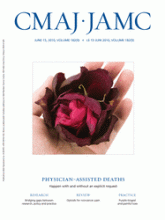Physician-assisted deaths
Physician-assisted deaths with an explicit request from the patient (euthanasia and assisted suicide) and those without an explicit request occurred in different patient groups and circumstances. This is the finding of a study from Belgium based on a questionnaire regarding end-of-life care that was sent to physicians certifying nearly 7000 deaths, and that identified 208 physician-assisted deaths. Patients less than 80 years old, those dying at home and those with cancer were most likely to make an explicit request. See Research, page 895
The role of nurses in physician-assisted deaths
A survey of 1678 nurses in Belgium identified 128 nurses who reported having cared for a patient who received euthanasia and 120 who reported having cared for a patient who received life-ending drugs without his or her explicit request. The nurses who reported administering the life-ending drugs, especially to patients who had not explicitly requested physician-assisted death, operated beyond the legal margins of their role, say the authors of this companion paper. See Research, page 905
Image courtesy of © 2010 Jupiterimages Corp.
Gaps between research, policy and practice
Researchers in low- and middle-income countries reported frequent engagement in only some types of activities to bridge gaps between research, policy and practice. This finding emerges from a survey by Lavis and colleagues of more than 300 researchers in 10 countries. The authors focused on engagement in three promising bridging activities and examined system-level, organizational and individual correlates of these activities. See Research, page E350
Changing the practice of health care providers
Locally conducted or published research has played an important part in changing the practice of health care providers surveyed in low- and middle-income countries. Access to the Internet was viewed as a significant factor in whether research-based evidence led to concrete changes in practice. Guindon and colleagues surveyed almost 1500 health care providers from 10 countries about their use of research-based evidence and examined factors that may facilitate or impede such use. See Research, page E362
Debriefing after critical incidents in schools
The interventions used in schools to debrief students after a stressful critical incident lack sufficient evidence of effectiveness. See Commentary, page 883
Use of opioids for chronic noncancer pain
Prescribers and dispensers can minimize potential harms associated with the use of opioids by assessing risks, educating patients, monitoring use over time, and reducing the dose of opioids or stopping them when indicated. This is a key message from the new Canadian practice guideline on the use of opioids for chronic noncancer pain. See Review, page 923
Just 3 of the 24 recommendations in the new Canadian practice guideline on the use of opioids for chronic noncancer pain are based on randomized controlled trials and the rest on consensus opinion. This is because of the lack of strong evidence, says Chou. See Commentary, page 881
Cholesterol microembolization syndrome
An elderly man with a history of hypertension and atrial flutter developed purple-tinged and painful toes after treatment with warfarin. Nonhemorrhagic complications, such as cholesterol microembolization syndrome, can occur with anticoagulant therapy. See Practice, page 931
Electronic health records and physicians’ pockets
The adoption of electronic health records by physicians will, arguably, have no impact on fee-for-service payment models or require doctors to abandon the payment model. See News, page 888
Image courtesy of © 2010 Jupiterimages Corp.













